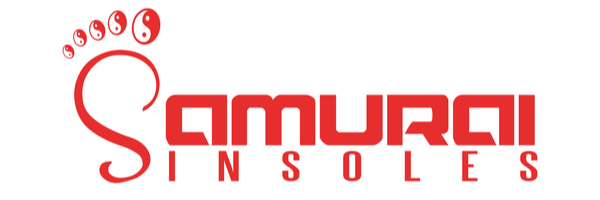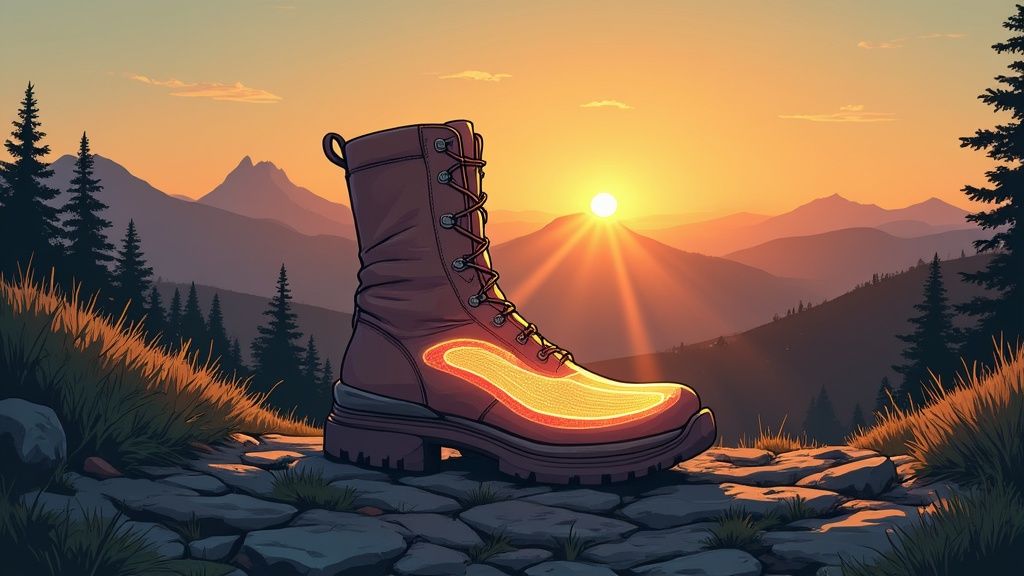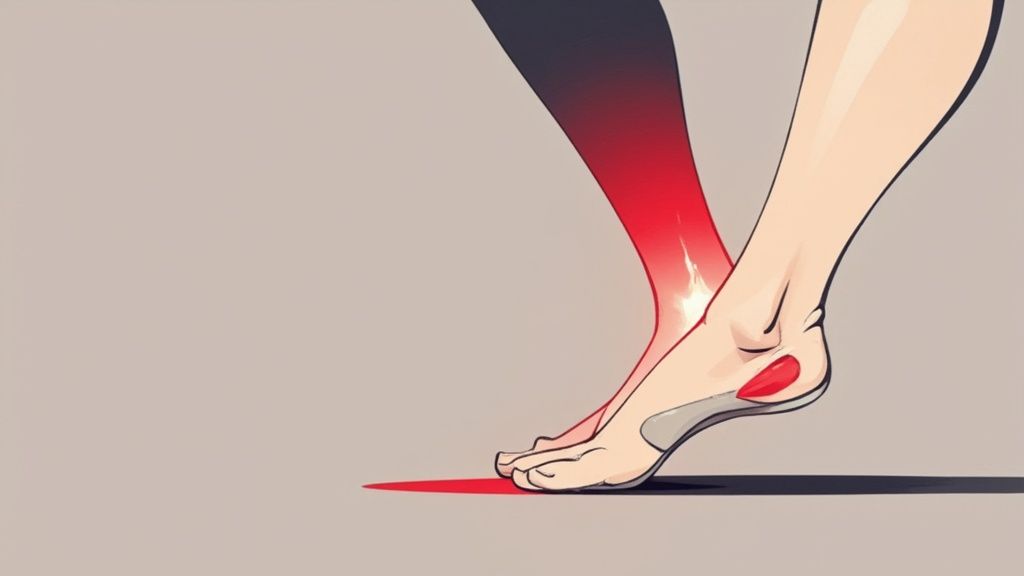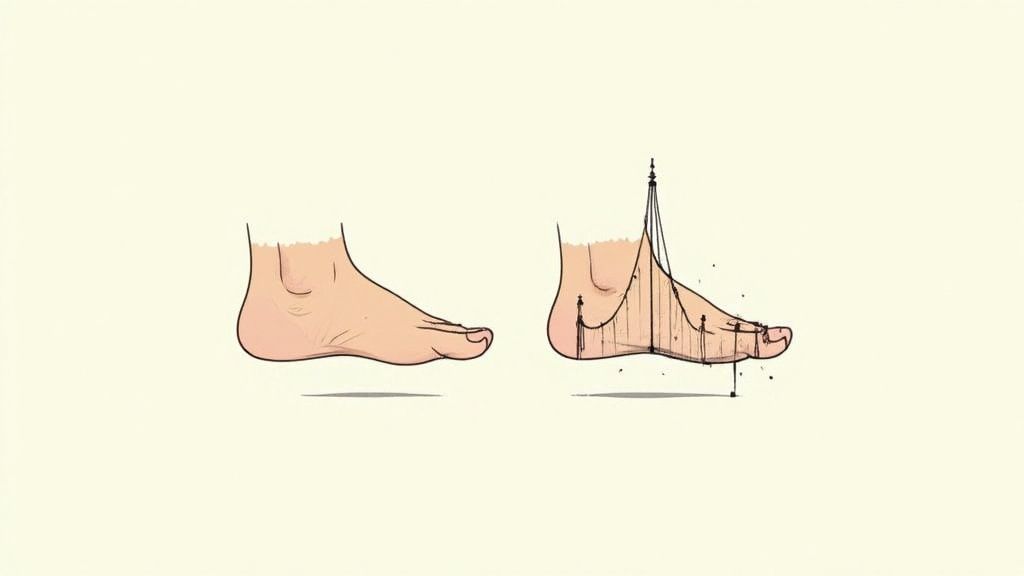When your feet are screaming after a long day, you don't want a long-term plan—you want relief now. The two best things you can do right away are using cold therapy to knock down inflammation and elevating your legs to reduce swelling. These simple tricks can make a world of difference in just a few minutes.
Find Immediate Relief for Your Aching Feet
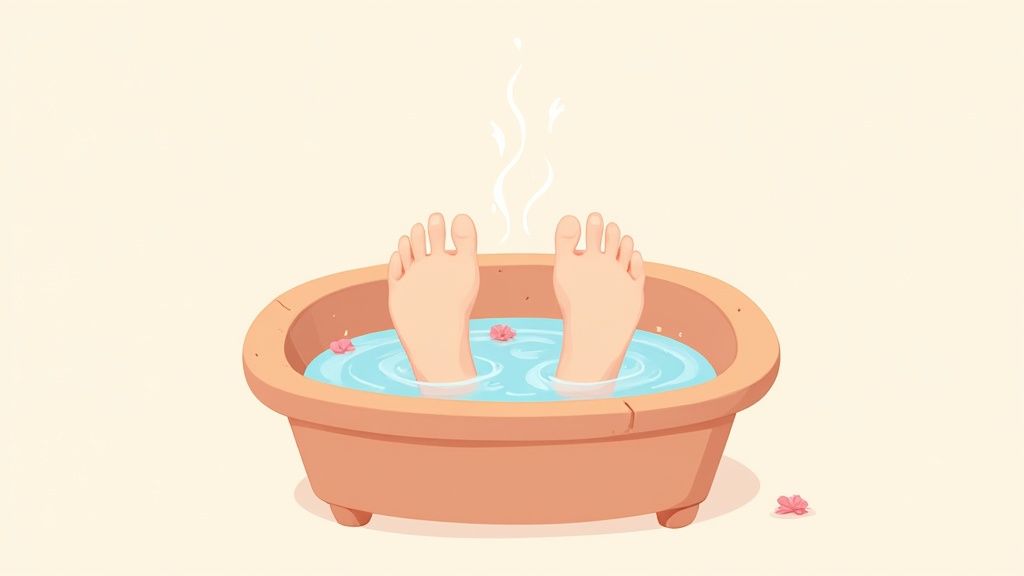
When that deep, throbbing ache in your feet is all you can think about, you need an emergency care routine. These are the things you can do the second you get home to calm the pain and start feeling human again. Best of all, they don't require any fancy equipment.
The mission is simple: attack the two main culprits of end-of-day foot pain—inflammation and fluid retention. Your feet have been under constant pressure, and that stress makes the tissues swell up and hurt.
Apply Cold Therapy
One of the most powerful ways to fight back against that inflammation is with cold therapy. It works by constricting your blood vessels, which helps numb the sore spots and dramatically reduces swelling. This isn't just a trick for pro athletes; it’s a go-to for anyone who’s been on their feet all day.
You've got a few easy ways to do this:
- Cold Water Soak: Just fill a basin or tub with cold water and soak your feet for 15-20 minutes.
- Ice Pack: Grab an ice pack (or even a bag of frozen peas), wrap it in a thin towel, and place it right on the most painful spots, like your arches or heels.
- Frozen Bottle Roll: Freeze a standard water bottle and roll it under each foot. This gives you the double benefit of cold and a gentle massage.
Expert Tip: The frozen water bottle is a personal favorite. It hits the plantar fascia just right, giving you a targeted massage and cold therapy all at once. It's incredibly effective.
For those looking for the fastest path to relief, I've put together a quick-action table. It breaks down what to do, why it works, and how long to do it for the best results.
Quick-Action Methods for Soothing Sore Feet
| Method | How It Works | Recommended Duration |
|---|---|---|
| Cold Water Soak | Submerges the entire foot to constrict blood vessels and reduce overall swelling. | 15-20 minutes |
| Ice Pack | Provides targeted cold to numb specific sore spots and decrease local inflammation. | 15 minutes per area |
| Leg Elevation | Uses gravity to help drain excess fluid that has pooled in your feet and ankles. | At least 15 minutes |
These methods are designed for immediate impact, helping you manage the acute pain so you can relax and recover.
Elevate Your Legs
Right after your cold therapy session, it's time to elevate. Propping your feet up higher than your heart lets gravity work for you, helping to drain all that excess fluid that's been building up in your lower legs and feet all day.
Simply lie down on the floor or a couch and rest your legs up against a wall or on a big stack of pillows. Try to stay there for at least 15 minutes to really let your circulatory system catch up.
If you want to turn this into a more relaxing ritual, you can incorporate these tips into a full at-home spa night. By combining cold and elevation, you're creating a powerful one-two punch that will leave your feet feeling refreshed and ready for another day.
Simple Stretches and Self-Massage to Revive Your Feet
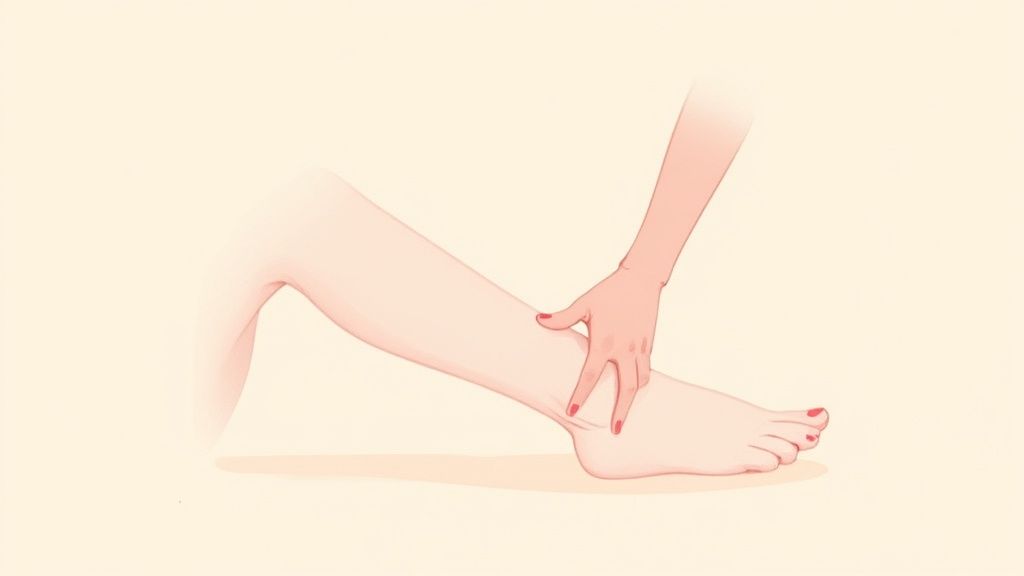
While kicking your feet up and icing them down can feel great in the moment, that’s often just temporary. For relief that truly lasts, you need to get in there and release the deep-seated tension in your muscles and tissues. This is where active recovery, like stretching and self-massage, comes in.
Don't worry, this isn't about starting some complicated, hour-long routine. These are simple, effective movements you can easily do while you’re unwinding on the couch or even sitting at your desk.
Think of the muscles in your feet like tiny, overworked rubber bands. After being on them all day, those bands get tight, stiff, and sore. Gentle, consistent stretching is what helps them regain their flexibility, heading off the chronic pain that can lead to bigger problems like plantar fasciitis.
Targeted Movements for Lasting Relief
The goal here is pretty simple: gently lengthen the muscles and ligaments that run through your arches, heels, and toes.
One of my all-time favorite, low-effort moves is the towel scrunch. Just lay a small hand towel on the floor, take a seat, and use only your toes to bunch it up toward you. It's a surprisingly effective way to wake up and strengthen all those small, intrinsic muscles that support your arch.
Another fantastic technique uses a common household item for a mini deep-tissue massage.
- The Tennis Ball Roll: Sit comfortably and roll a tennis ball (or a lacrosse ball for deeper pressure) under your foot, moving slowly from your heel to your toes. When you find a tender spot, just pause and apply gentle pressure for about 15-20 seconds. You’ll feel the knot start to release.
- The Frozen Bottle Roll: This is a great two-for-one. Use a frozen water bottle instead of a ball. The icy cold helps numb the pain and reduce inflammation while the rolling motion works out the tightness in your plantar fascia.
The real secret isn't doing one marathon session, but being consistent. Spending just five minutes a day on this can make a world of difference, stopping stiffness and pain before they even have a chance to set in.
Building Your Simple Foot Care Routine
The key to making this work is to build a habit you can actually stick with. Don’t try to do everything at once.
Just pick one stretch and one massage technique to do each evening. Maybe you do towel scrunches during a commercial break and then roll your feet on a tennis ball while you catch up on emails. Easy.
By consistently giving your feet this little bit of attention, you're building up their resilience and making them less prone to getting tired and sore. If you’re looking for exercises tailored to a specific issue, you might want to check out our guide on foot stretches for flat feet, which is a big help for anyone who deals with overpronation.
Why Your Shoes Are Often the Real Culprit
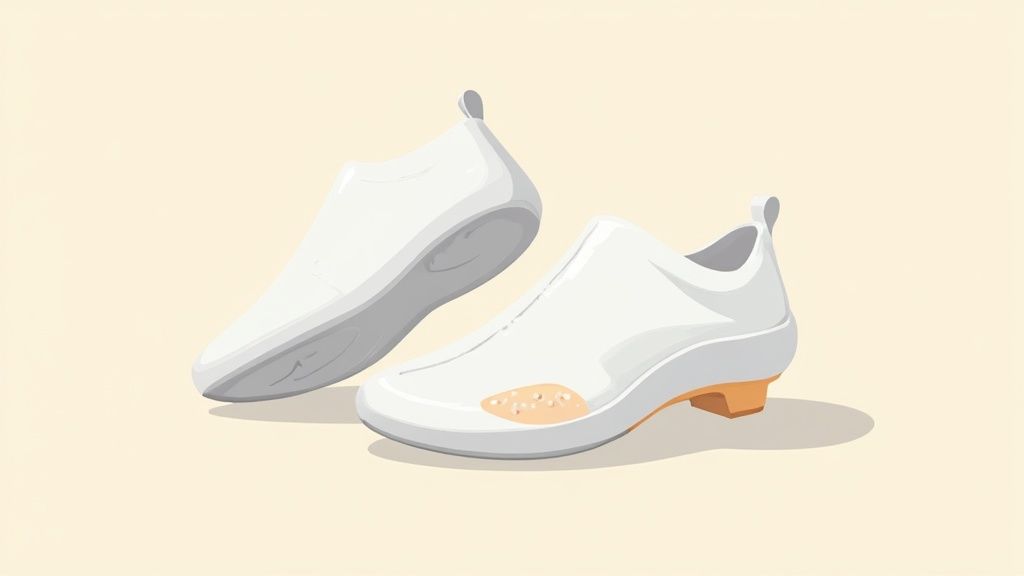
While stretches and massages are fantastic for immediate relief, they’re really just treating the symptoms. If you want to get ahead of foot pain and stop it before it even starts, the answer is usually right there on your feet.
Your shoes are the foundation for your entire body. When that foundation is weak, your feet are the first to feel it. I see it all the time—people choosing style over substance, not realizing they’re setting themselves up for a world of hurt. Those flimsy sneakers or stylish shoes with a narrow, pointed front might look great, but they offer next to nothing in the way of real support.
What Really Makes a Shoe Supportive?
When you’re trying to figure out how to relieve tired feet for good, prevention is always the best medicine. This means wearing shoes that actually work with your foot's natural structure, not against it.
Here’s what you should be looking for:
- Real Arch Support: Your arch is your body's built-in shock absorber. When a shoe doesn't support it, your arch can flatten out, leading to strain and painful conditions like plantar fasciitis.
- Plenty of Cushioning: Every single step sends shockwaves up through your legs. Proper cushioning is what softens that blow, protecting the delicate bones and tissues in your feet.
- A Roomy Toe Box: Your toes need to spread out naturally when you walk. A cramped toe box forces them together, which can lead to bunions, hammertoes, and just plain old pain.
Think of your shoes as your first line of defense against fatigue. If that defense is weak, your feet will be paying the price by the end of the day. Upgrading your footwear isn't an indulgence—it's a fundamental part of your health.
The Power of a Good Insole
Even a decent pair of shoes can fall short of giving your unique feet the exact support they need. This is where a quality insole can be a total game-changer, turning an average shoe into a personalized support system. It’s one of the easiest ways to dramatically boost your comfort without having to buy a whole new shoe collection.
Orthopedic foot insoles are a huge part of the solution, especially for those dealing with plantar fasciitis. It's no surprise that the market for these supports hit around USD 4.68 billion in 2023. As more people realize the benefits of proper foot support, the demand just keeps growing.
Of course, not all inserts are created equal. It's important to know what you're buying. To get a better handle on what might be right for you, take a look at our guide explaining the difference between orthotics and insoles.
Give Your Feet the Support They Deserve with Samurai Insoles
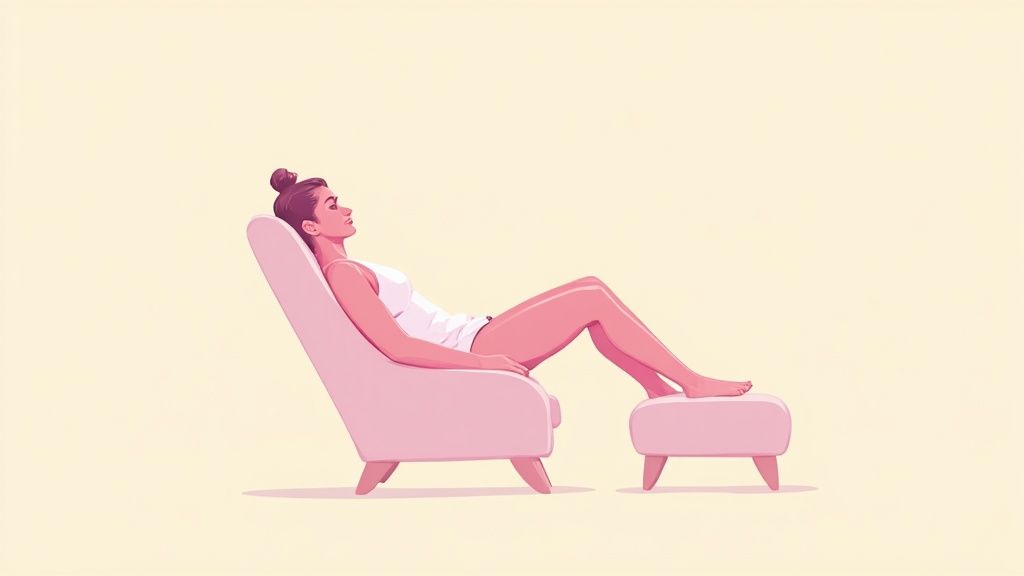
Sometimes, even the best shoes aren't enough. If you’ve tried those generic, flimsy inserts from the drugstore and still feel like you’re walking on rocks by the end of the day, it's time for a real upgrade. Standard solutions often miss the mark because they don’t actually address how your foot moves and functions.
That’s where a properly engineered, lab-tested solution like Samurai Insoles truly shines. Unlike basic foam or gel pads that just offer a bit of squishy cushioning, Samurai Insoles are built to actively correct your foot’s mechanics. They provide targeted arch support that helps realign your entire foot and ankle, which is a game-changer for relieving tired feet. This smart design redistributes pressure away from hotspots like your heels and the balls of your feet.
Targeted Support for Demanding Days
For anyone who spends a lot of time on their feet, this kind of support isn't just nice to have—it's essential. I'm talking about nurses pulling 12-hour shifts on hard hospital floors, retail workers standing all day on concrete, or even dedicated runners pushing their limits.
In these situations, the foot's natural arch can start to collapse under constant stress, leading to a chain reaction of pain and fatigue. Samurai Insoles act like a supportive scaffold, preventing that collapse and keeping your feet in a healthier, more efficient position. The result is a dramatic reduction in those end-of-day aches.
The concept is simple but incredibly effective: By supporting the arch correctly, you take the load off the parts of your foot that are being overworked. This helps stop fatigue before it even starts, rather than just trying to soothe the pain afterward.
The world of foot care is constantly evolving. We're even seeing smart insoles emerge that can monitor foot pressure, showing a clear demand for effective, personalized solutions.
If you're dealing with a specific and painful issue like plantar fasciitis, getting the right insole is even more critical. To learn more, check out our complete guide to insoles for plantar fasciitis relief and find the perfect support for your needs.
Make Your Environment Easier on Your Feet
Think about the ground you stand on all day. Whether it's the tile in your kitchen, the hardwood at home, or the concrete floor at your job, these surfaces are incredibly unforgiving. They have zero give, which means your feet, knees, and even your back absorb the full shock of every step you take.
This constant, low-grade impact really adds up over time. It's a major reason why you feel that deep, persistent ache after a long day. The good news is, you can change this. One of the most effective ways to fight back is by introducing an anti-fatigue mat into your daily routine.
Putting one of these mats where you stand the most—at your standing desk, in front of the kitchen sink, or on your workshop floor—can honestly feel like a revelation for tired feet.
So, How Do These Mats Actually Help?
It's not magic, just clever design. An anti-fatigue mat is made from a cushioned material that creates a slightly unstable surface. You won't feel like you're about to fall over, but the instability is just enough to make your leg muscles constantly work with tiny, unconscious micro-adjustments to keep you balanced.
This does a couple of really important things for your body:
- Keeps Blood Flowing: Those tiny muscle movements act like a pump, boosting circulation and stopping blood from just sitting in your lower legs and feet.
- Takes the Pressure Off: The cushioning itself acts as a shock absorber, soaking up the impact that would normally travel right up your legs and spine.
These mats are so effective that workplaces are taking notice. The market for them was already worth around USD 1.7 billion back in 2022, and it's only getting bigger as more companies realize how much they help their employees. This trend shows a growing understanding of just how critical our standing environment is to our overall well-being. If you're curious, you can explore more about these market trends and see why this is becoming such a big deal.
My Take: Standing on a hard floor all day is like tapping your heel with a small hammer over and over again. An anti-fatigue mat is like putting a thick piece of foam rubber between the hammer and your foot. It simply absorbs the hit so you don't have to.
By making a simple change to the surfaces you stand on, you stop fighting a losing battle against foot pain. You’re proactively preventing the ache from starting in the first place, giving your feet a break all day long.
Got Questions About Beating Tired Feet? We've Got Answers
Even with the best tips, it's natural to have a few questions when you're trying to figure out how to finally get rid of those tired, aching feet. Let's walk through some of the ones I hear most often so you can feel confident in your plan.
How Often Should I Really Be Stretching My Feet?
Honestly, consistency is everything. You don't need to block out a huge chunk of your day. Just 5-10 minutes of gentle stretching daily can make a world of difference. Think of it as a small daily ritual for your feet.
I find that doing a few quick stretches in the morning is great for waking up my feet and getting them ready for the day ahead. Then, another short session in the evening works wonders to release all that tension that's built up. This daily habit is far more powerful than a single, long session once a week.
A Quick Word of Advice: Always listen to your body. If you feel a sharp or sudden pain, you're pushing it too far. The goal here is a gentle, relieving stretch, not an intense, painful workout.
Is It True That My Shoes Could Be Causing My Back and Knee Pain?
You bet. It's a connection people miss all the time. Your feet are literally the foundation for your entire body. When that foundation is off-kilter, the instability creates a chain reaction that travels all the way up.
Imagine wearing shoes with zero support. Your foot flattens or rolls, which changes the angle of your ankle. Your body then tries to compensate, which throws off the alignment of your knees, hips, and eventually your lower back. This forces muscles and joints to take on stress they weren't built for, leading to that chronic knee or back ache that just won't quit.
When Should I Stop Trying Home Remedies and See a Doctor?
Most of the time, you can handle tired, achy feet at home. But there are definitely some red flags that mean it's time to call in a professional. You should book an appointment with a doctor or podiatrist if you're experiencing:
- Pain That Won't Quit: Your foot pain isn't getting any better after a week or two of consistent self-care.
- Sharp, Shooting Pains: This could be a sign of a nerve issue or a more serious injury.
- Numbness or Tingling: Any loss of sensation is a major warning sign that needs to be checked out.
- Swelling That Sticks Around: If swelling doesn’t improve with ice and keeping your foot elevated, it's time for a professional opinion.
These symptoms can point to an underlying problem that really needs a proper diagnosis and a specific treatment plan from a medical expert.
Ready to give your feet the support they've been missing? Stop tired feet before they start with Samurai Insoles. Find your perfect fit and feel the difference today.
